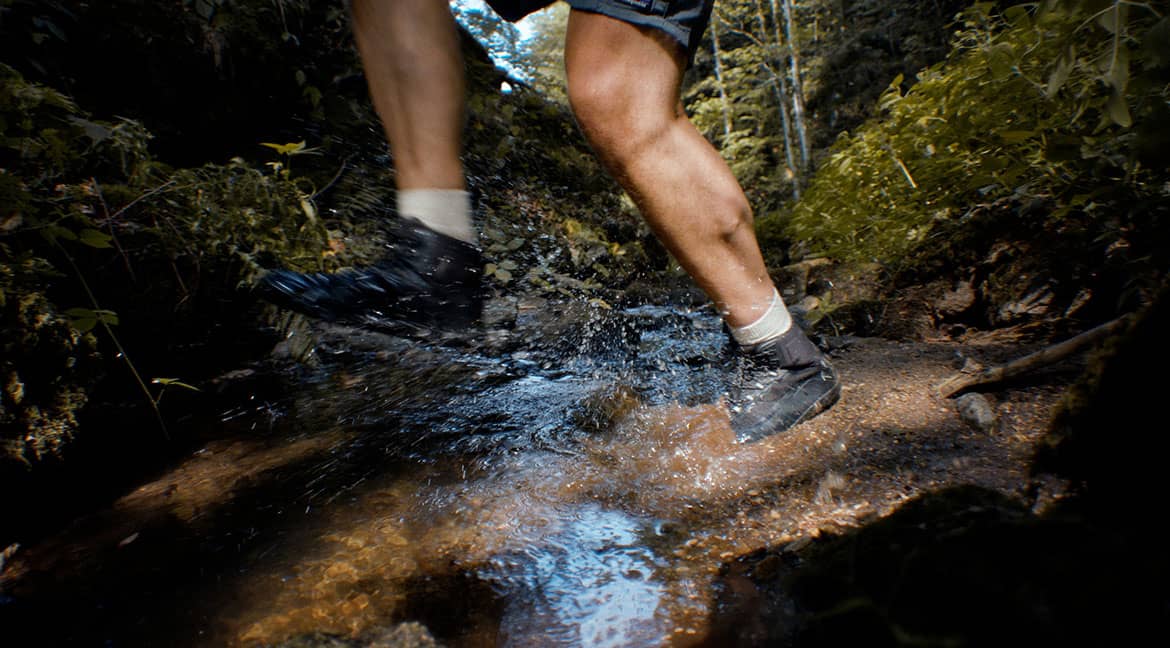Groundies Outdoor: The best barefoot shoes for hiking
Hike happy with Groundies barefoot shoes. Learn more about the benefits of barefoot shoes here.
Can you go hiking with barefoot shoes? Sooner or later, anyone who has experienced the comfort and pleasure of barefoot shoes will ask themselves this question. For our Groundies experts, the answer is a resounding “yes!” Nevertheless, there are a few important things you need to keep in mind before hiking with barefoot shoes. In this article, we’ll go over everything you need to know to make the most of your outdoor adventures.
Hiking with barefoot shoes – The basics
Hitting the trails with a lightweight backpack and some barefoot hiking shoes is a great way to experience nature. The soles of barefoot hiking shoes are extremely thin, just like regular barefoot shoes. However, barefoot hiking shoes offer more support and grip than barefoot sneakers or casual barefoot shoes. They are also much lighter than regular hiking shoes. In fact, a Groundies barefoot hiking shoe only weighs around 300 grams (0.66 lbs), compared to as much as 1,800 grams (4 lbs) for a regular hiking shoe.
Characteristics of barefoot hiking shoes
Barefoot hiking shoes are comfortable, protective, and perfectly adapted to the shape of your feet. The best barefoot hiking shoes are designed with sturdy, waterproof uppers and high-grip, non-slip soles. Our GX1 Multi-Terrain Sole, which can be found on the Groundies Ontario Woman, provides for outstanding traction at all times – even on difficult trails. On longer hikes, sufficient breathability is a must to prevent your feet from retaining sweat and overheating. A shoe with a breathable lining (such as a soft microfiber membrane) will be an excellent choice here. As with all hiking shoes, barefoot hiking shoes need special hiking socks, preferably made of a blend of breathable wool, elastane, and synthetic materials.
Hiking in barefoot shoes – Things to know before you head out
Before shopping for barefoot hiking shoes, ask yourself the following question: Have you ever hiked in barefoot shoes? If so, for how long? Since barefoot hiking shoes are like a second skin, they tend to work more muscles than regular hiking shoes. Even seasoned hikers will need to exert more strength and energy in the beginning. Be sure to take this into account when switching to barefoot hiking shoes. Another important factor is the length of the hike. For short and easy hikes, outdoor barefoot shoes with a medium grip are more than sufficient. However, if you plan on going on a long or even multi-day hiking tour with barefoot shoes, you’ll need a pair that provides for outstanding traction (e.g., multi-terrain soles) and stability.
The trail – Safe hiking with barefoot hiking shoes
Before embarking on any hike, you need to assess the trail. The characteristics of the terrain are just as important as the length of the hike. Will you be hiking on dry and flat land? Or on a difficult trail with elements such as sand, mud, wet roots, or sharp or slippery stones? If in doubt, opt for sturdy, stable, non-slip barefoot shoes instead of lightweight everyday barefoot shoes. You’ll also need to think about the weather on the day of your hike. If you'll be hiking on dry terrain, then your feet will need breathable barefoot shoes. If there’s a chance of rain, then waterproof barefoot shoes with non-slip soles and excellent grip (such as our Groundies All Terrain High Men shoes) will be a better bet.
Switching from regular hiking shoes to barefoot hiking shoes
Switching to barefoot hiking shoes is a piece of cake. However, you’ll want to go easy on yourself in the beginning by starting out at a slow pace. Short hikes (3 to 5 km//2 to 3 miles) will help you get used to your new barefoot hiking shoes. Barefoot hiking shoes should be neither too small nor too big. As a rule of thumb, opt for your usual size. If you’re between two sizes, go with the bigger one. Keep in mind that feet tend to swell and expand over the course of the day. It’s therefore a good idea to try on new barefoot hiking shoes in the afternoon or evening. High-quality barefoot hiking shoes will adapt to your feet, overall balance, and physical condition. Don’t skimp when purchasing barefoot hiking shoes. A premium pair of barefoot outdoor shoes usually costs around 160 to 190 euros. However, when properly cared for, they’ll provide for years of pleasure.
Barefoot hiking shoes: Good to know
- High-quality barefoot hiking shoes will usually last for 1,000-2,000 kilometers (600-1,200 miles).
- Barefoot hiking shoes should be properly cared for to ensure they last as long as possible. This includes their storage. For more tips on shoe care, click here.
- After a hike, barefoot hiking shoes should be cleaned immediately. Remove caked-on dirt with a brush, then soak the shoes in lukewarm water (if necessary) and apply a waterproof treatment after they have dried.
- Barefoot hiking shoes should fit just right to provide the necessary support for hiking. If they are too tight, then bruises or blisters can form on your feet.
- The ankle shafts should gently enclose and properly support your feet, without squeezing them.
- After 15 to 20 minutes on the trail, re-tighten your shoelaces.
















